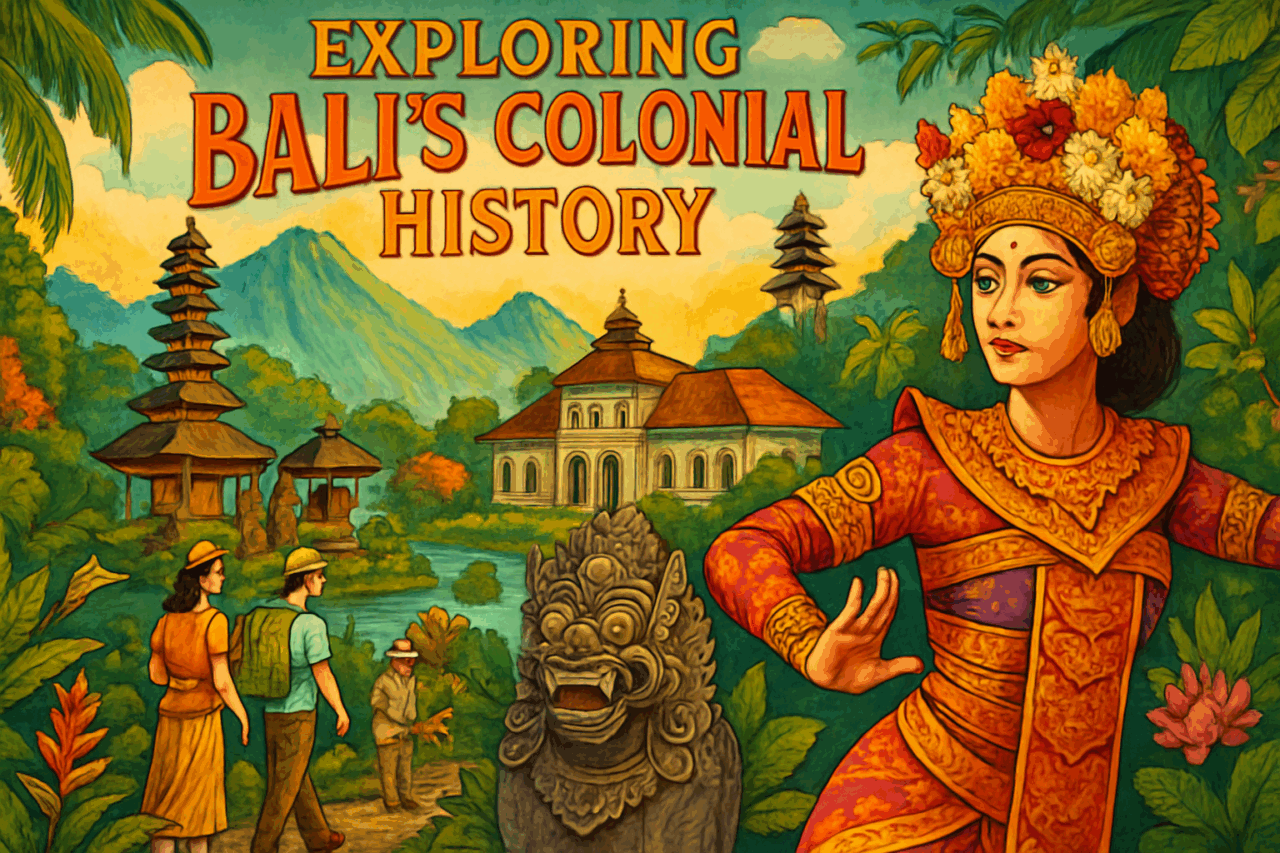Exploring Bali’s Colonial History: Echoes of the Past in the Island of the Gods
By Jayantha
Imagine the sun dipping behind a silhouette of emerald rice terraces, the air tinged with incense and sea salt, and the distant chime of a gamelan orchestra floating through the breeze. Bali—a paradise famed for its surf, sunsets, and spiritual energy—holds a secret layer beneath the postcard perfection: a rich, tangled colonial history that shaped its temples, traditions, and tenacious spirit.
As a Sri Lankan traveler drawn to islands with stories, Bali’s colonial journey feels both familiar and thrillingly unique. Let’s peel back the layers, from Dutch footprints to Balinese resistance, and discover how past and present entwine in Bali’s vibrant tapestry.
Colonial Shadows: When the Dutch Came Ashore
Bali’s colonial tale isn’t as straightforward as many Southeast Asian narratives. While neighboring Java and Sumatra fell quickly under Dutch rule, Bali’s kingdoms fiercely resisted foreign control well into the 19th century. The Dutch first cast greedy glances at the “Island of the Gods” in the early 1800s, lured by tales of spices and riches. But the Balinese were no strangers to invaders—they’d fended off Javanese kings and European pirates alike.
The real push began in the 1840s, with a series of brutal military expeditions. The Dutch, with gunboats and cannons, faced off against Balinese warriors armed with kris daggers and unbreakable pride. The result? Tragedy and heroism etched into Bali’s soul.
The Puputan: Bali’s Defiant Sacrifice
One of Bali’s most poignant colonial moments is the Puputan—a ritual mass-suicide—a word that chills the spine. In 1906, as Dutch troops advanced on Denpasar, the royal family and hundreds of followers dressed in their finest, walked solemnly into the streets, and chose death over surrender.
Today, you’ll find a striking monument in Denpasar’s Puputan Square, depicting Balinese warriors in timeless defiance. Sitting there at golden hour, I felt the echo of their sacrifice, a reminder that Bali’s beauty is born from resilience as much as ritual.
Colonial Traces: Where to See History Alive
1. Royal Palaces and Colonial Mansions
Stroll through Ubud’s Puri Saren Agung (Royal Palace), and you’ll spot traces of European influence—arched windows, ornate gates, and lush, symmetrical gardens. Many palaces, like the Water Palace in Amlapura, blend Dutch architecture with Balinese carvings, creating a dreamlike fusion of east and west.
Pro tip: Arrive early in the morning when the stone courtyards are awash in sunlight and serenely empty—a perfect backdrop for your Instagram feed and a moment to imagine royal life under colonial shadow.
2. Bali Museum (Denpasar)
Housed in a cluster of colonial-era buildings, the Bali Museum is a treasure chest of artifacts: ancient kris blades, royal costumes, and haunting photographs from the Dutch occupation. The museum’s old-world charm—mossy courtyards and dragon-guarded gates—feels like stepping into a sepia photograph.
3. Colonial Churches and Old Dutch Quarters
In Singaraja, the former colonial capital, pastel-hued churches and Dutch villas line sleepy streets. The Gedong Kirtya Library, once a Dutch administrative building, now houses Bali’s largest collection of lontar manuscripts—palm-leaf books brimming with old Balinese wisdom.
Wander here by bicycle, and you’ll catch glimpses of daily life unchanged for generations: fishermen mending nets, elders sipping kopi Bali on shady verandas, schoolkids laughing beneath frangipani trees.
Cultural Connections: The Dutch, the Balinese, and Beyond
Colonialism isn’t just a story of conquest; it’s a story of exchange. Dutch botanists fell in love with Bali’s orchids and spices, artists from Leiden sketched temple dancers, and Balinese princes traveled to Batavia (now Jakarta) to learn the new world order.
Yet, through it all, Bali’s spiritual core stood firm. The Dutch tried to ban cockfighting and cremation ceremonies—only to find the rituals too deeply rooted to erase. Today, the collision of cultures is Bali’s signature. You’ll taste it in the coffee (Dutch influence), hear it in the hybrid jazz-gamelan bars of Seminyak, and see it in the colonial-era art still hanging in Ubud’s galleries.
Why Bali’s Colonial Past Matters to Young Travelers
For those of us who crave more than beach clubs and smoothie bowls, Bali’s colonial history is a portal to meaning. It’s a chance to connect with the struggles and triumphs that shaped this island’s legendary spirit. It’s a reminder that paradise, like people, bears scars—and that’s what makes it real.
Every time I wander a mossy palace, sip coffee in a Dutch-era café, or stand in silent tribute at Puputan Square, I feel the pulse of Bali’s story—a rhythm that’s at once ancient and urgently alive.
So, next time you find yourself lost in Bali’s beauty, take a detour into the past. Listen for the whispers of history in the rustle of bamboo, the crackle of temple drums, and the soft, stubborn heartbeat of an island that never truly surrendered.
Practical Tips for History-Hunters:
- Best Time to Explore: Early mornings or late afternoons, when the light is soft and crowds are thin.
- Getting Around: Rent a scooter for maximum freedom, or join a guided heritage tour for in-depth stories.
- Dress Code: Modest attire is a sign of respect when visiting palaces and temples—think sarongs and covered shoulders.
- Local Reads: For a deeper dive, try “Bali: A Paradise Created” by Adrian Vickers, or hunt for colonial-era maps and photos at Bali Museum.
Bali’s colonial past may be shadowed by hardship, but it’s also brilliantly alive—woven into every carving, every festival, every sunset that lights up the island’s sky. Come for the beaches, stay for the stories. History, here, is not just in the books. It’s in the air you breathe.
Selamat jalan, fellow explorers. May Bali’s past inspire your next adventure!

Comments (0)
There are no comments here yet, you can be the first!